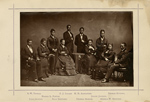Photographic Processes: 1839 – 1889
NON-SILVER PHOTOGRAPHIC PROCESSES
CARBON PRINT, 1865-1950
Non-silver paper based positive with pigment as final image material in gelatin layer
Paper is coated with a mixture of carbon ink (or other suitable pigment) and bichromated gelatin and is exposed to light through direct contact with a negative. The gelatin hardens selectively in proportion to the amount of light it receives through the different densities of the negative. The exposed carbon/gelatin paper is then pressed against a second sheet of paper and soaked in hot water. The unhardened gelatin/carbon mixture dissolves in hot water and the original paper is peeled away, leaving the hardened gelatin and carbon image registered on the second sheet of paper.
The dark areas of the print have more gelatin than the light areas and will appear glossier. The pigment used is usually very stable and the image generally shows no signs of fading.
 |
Unidentified. Carbon Print, ca. 1875. [zoom] 3 5/8 x 5 1/4 in. Fisk University’s Jubilee Singers achieved worldwide fame. Their tours throughout England, Europe and America raised funds for their pioneering African-American university and countered stereotypes about black musicianship. |